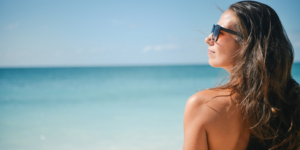Protect your Eyes this Summer against UV lights
Most people know the sun’s rays are bad for our skin. But did you know they’re just as bad for our eyes? We all use sunscreen to protect our skin, but don’t forget to protect your eyes as well. Sunglasses are a great fashion accessory, but their most important job is to protect your eyes from the sun’s ultraviolet (UV) rays. Too much UV light exposure can increase your risks of developing different eye diseases including cataract and pterygium.
• Cataracts, a clouding of the eye’s lens that can blur vision. An estimated 20% of cases are caused by extended UV exposure.
• Pterygium, a tissue growth over the white part of the surface of the eye that can alter the curve of the eyeball, causing astigmatism.
When purchasing sunglasses, look for one’s that block out 99 to 100% of both UV-A and UV-B radiation. This can keep your vision sharp and eyes healthy. A wide-brimmed hat or umbrella offers great protection too!
Diseases like cataract and eye cancers can take many years to develop, but each time we’re out in the sun without protection we could be adding damage that increases our risks for these eye conditions over time. Babies and kids need to wear hats and sunglasses to help preserve their vision as they get older. Regardless of age, we all should take safety measures when exploring the outdoors.
Growths on the eye, such as pterygium, can show up in our teens or twenties, especially in surfers, skiers, fishermen, farmers, or anyone who spends long hours under the mid-day sun or in the UV-intense conditions found near rivers, oceans, and mountains.
Follow these tips to protect your eyes from the sun all year long:
• Sun damage to eyes can occur anytime during the year, not just in the summertime, so be sure to wear UV-blocking sunglasses and broad-brimmed hats whenever you’re outside.
• Select wrap around styles so the sun rays cannot enter from the side of your glasses.
• Never look directly at the sun. Looking directly at the sun at any time, including during an eclipse, can lead to solar retinopathy, which is damage to the eye’s retina from solar radiation.
• Don’t forget the kids and older family members: everyone is at risk, including children and senior citizens. Protect their eyes with hats and sunglasses.
• The sun’s rays can pass through haze and clouds. Sun damage to the eyes can occur any time of year, not just in summer.
• Sunlight is strongest mid-day to early afternoon, at higher altitudes, and when reflected off of water, ice or snow.
According to a national Sun Safety Survey conducted by the American Academy of Ophthalmology, only about half of people who wear sunglasses say they check the UV rating before buying. The good news is that you can easily protect yourself. By embracing these simple tips you and your family can enjoy the summer sun safely while protecting your vision.
If you are concerned about your vision, call our office and schedule your eye exam today at 916-446-2020!

